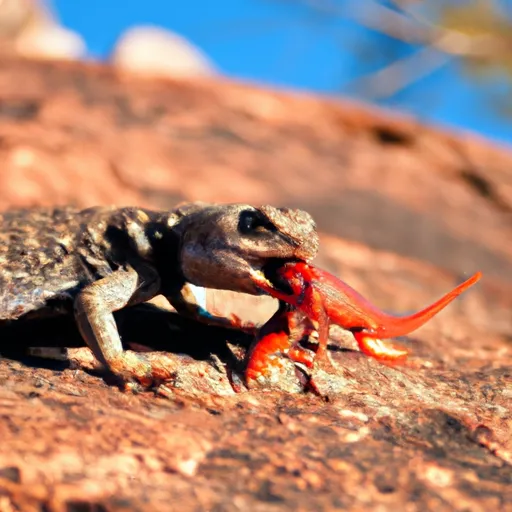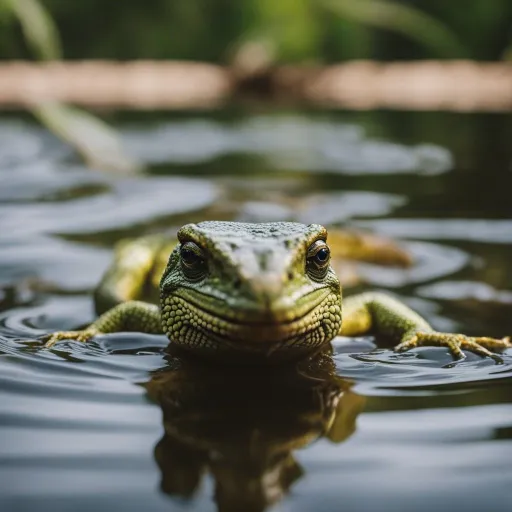So, you’re curious about what lizards feast on in the vast desert wilderness of Arizona? Well, you’ve come to the right place.
In this article, we will uncover the fascinating dietary habits of these scaly creatures and explore the diverse array of creatures they call lunch.
From insects to small rodents, prepare to discover the surprising culinary preferences of Arizona lizards.
So, grab a cold drink, put on your adventurer’s hat, and let’s embark on a journey into the desert kingdom of these incredible reptiles.
Overview of Lizard Diets in Arizona
Arizona is home to a diverse range of lizard species, each with its own unique dietary preferences and adaptations.
Understanding these diets is crucial for gaining insights into their ecological role and the overall health of their populations.
Lizards in Arizona primarily feed on insects, other arthropods, small vertebrates, and even plant matter.
Their diets are influenced by the arid environment in which they live, leading to interesting adaptations and foraging strategies that sustain their survival.
Types of Lizards in Arizona
Arizona boasts an impressive array of lizard species, including the common collared lizard, chuckwalla, desert spiny lizard, horned lizard, and many more.
Each species has evolved distinct feeding habits and preferences based on factors such as size, habitat, and physiological characteristics.
These differences contribute to the overall diversity of the lizard community and are fascinating to explore.
General Feeding Habits
Lizards in Arizona exhibit a variety of feeding habits, influenced by their specific species and available food sources.
While some lizards are strict insectivores, relying solely on insects as their primary food source, others consume a more varied diet that includes small vertebrates, arthropods, and even vegetation.
These general feeding habits provide a foundation for understanding the specific dietary adaptations seen within the lizard population.
Dietary Adaptations to the Arid Environment
The arid environment of Arizona poses unique challenges for lizards, requiring specific adaptations to ensure their survival. Lizards have developed physiological and behavioral adaptations to thrive in this harsh environment, including water conservation methods and efficient digestion. These adaptations play a pivotal role in their ability to obtain nutrients from their diet, especially given the scarcity of food and water.
Insects as the Primary Food Source
Insects form the primary food source for many lizard species in Arizona, largely due to their abundance and high protein content. Lizards have evolved various strategies for hunting and consuming a wide range of insects, ensuring they obtain the necessary nutrients for growth and maintenance.
Variety of Insects Consumed
Lizards in Arizona consume a diverse range of insects, including ants, beetles, grasshoppers, crickets, and termites. Each lizard species exhibits preferences for certain types of insects, influenced by factors such as size, availability, and nutritional content. By consuming a variety of insects, lizards can acquire a balanced diet rich in proteins, vitamins, and minerals essential for their well-being.
Insect Hunting Techniques
Lizards employ a multitude of hunting techniques to secure their insect prey. Some species rely on stealth and speed, rapidly pouncing on unsuspecting insects with lightning-fast reflexes. Others use their acute vision and sense of smell to detect and capture their quarry. Furthermore, certain lizard species possess specialized adaptations, such as adhesive toe pads or long tongues, which aid in capturing their insect prey with precision and efficiency.
Seasonal Availability of Insects
In Arizona’s arid environment, the availability of insects can fluctuate with seasonal changes. Lizards must adapt their foraging patterns to account for the varying abundance of insect species throughout the year. During peak insect seasons, lizards may experience an abundance of prey, allowing them to satisfy their nutritional needs. However, during periods of scarcity, lizards may face challenges in finding sufficient food sources and need to adjust their feeding behavior accordingly.
Other Arthropods in the Diet
While insects dominate the diet of many lizards, other arthropods also contribute significantly to their nutritional intake. Spiders, scorpions, centipedes, and millipedes are among the arthropods that lizards commonly consume, providing additional sources of protein and other essential nutrients.
Spiders
Spiders are a common component of lizard diets in Arizona. Lizards often consume various types of spiders, ranging from small orb-weavers to larger hunting spiders. The hunting techniques employed by lizards when targeting spiders may differ from those used for insects due to the unique characteristics and behaviors of these arachnids.
Scorpions
Scorpions, although potentially dangerous to humans, are a regular part of many lizard diets. Lizards have developed adaptations, such as thick scales and immunity to scorpion venom, that allow them to safely consume these arachnids. Scorpions provide a valuable source of protein and contribute to the overall diversity of the lizard diet.
Centipedes and Millipedes
Lizards in Arizona also feed on centipedes and millipedes, which are abundant in certain habitats. These arthropods offer a distinct source of nutrition for lizards, providing essential amino acids and minerals. Lizard species that specialize in consuming centipedes and millipedes have unique adaptations, such as specialized dentition or immunity to the chemicals some of these arthropods produce.
Small Vertebrates as Prey
While insects and arthropods form the bulk of most lizard diets, many species also include small vertebrates as part of their regular prey. This may include rodents, birds, bird eggs, amphibians, and even other lizards. The consumption of small vertebrates allows lizards to diversify their nutrient intake and adapt to changes in insect availability.
Rodents
Rodents, such as mice and rats, are occasional prey items for certain larger lizard species. Lizards that include rodents in their diet have evolved stronger jaws and improved hunting techniques to effectively catch and subdue these small mammals. Rodents provide a rich source of protein and can be an important dietary component during periods when insect populations are low.
Birds and Bird Eggs
Some lizard species in Arizona have been observed preying upon birds and their eggs. This behavior is more commonly seen in larger lizard species with robust jaw structures that allow them to capture and consume avian prey. Birds and their eggs offer a significant nutritional resource for lizards, particularly in areas where bird populations are abundant.
Amphibians
Lizards also include amphibians, such as frogs and tadpoles, in their diet. Amphibians provide an additional source of protein and other critical nutrients that assist in lizard growth and maintenance. The consumption of amphibians varies among lizard species, with some exhibiting a strong preference for this food source while others consume amphibians opportunistically.
Other Lizards
In an intriguing display of intraspecific predation, some lizard species in Arizona consume smaller, conspecific lizards. While this behavior occurs less frequently than the consumption of other prey items, it highlights the complex dynamics within lizard communities and the potential for competition and predation even within the same species.
Vegetative Matter and Plant-Based Prey
Although lizards are typically thought of as carnivorous, many species in Arizona incorporate vegetative matter and plant-based prey into their diets. These herbivorous lizards have unique adaptations and rely on specific plants as a vital nutritional resource.
Importance of Plants in Lizard Diets
Plants play a crucial role in the diets of herbivorous lizard species. They provide essential nutrients, such as carbohydrates, fiber, and vitamins, that may be lacking in a strictly carnivorous diet. Plants also contribute to hydration, as they contain moisture, helping to supplement the limited water availability in the arid environment.
Herbivorous Lizard Species
Certain lizard species in Arizona have evolved to primarily consume plant matter, displaying specialized adaptations. Their teeth and jaws are modified for efficiently chewing and grinding vegetation, enabling them to extract nutrients from tough plant tissues. These herbivorous lizards have developed intricate relationships with specific plant species, forming a delicate balance that ensures their survival.
Cacti and Succulents as Food Sources
Cacti and succulents are prominent components of the Arizona desert landscape, and some lizard species have adapted to consume them. These plants offer a unique source of moisture and nutrients, allowing lizards to thrive even in the face of limited water availability. Lizards that specialize in cacti and succulent consumption have specialized gut structures that aid in extracting and digesting the necessary nutrients from these plants.
Impact of Diet on Lizard Behavior
The diet of lizards in Arizona has far-reaching implications beyond mere nutrition. It significantly influences their behavior, including foraging methods, territoriality, competition, reproduction, and growth. Understanding these connections sheds light on the complex interactions between lizards and their environment.
Foraging Methods and Strategies
Lizards employ various foraging methods and strategies based on their diet. Insectivorous lizards often rely on agility, speed, and stealth to capture fast-moving prey, while herbivorous lizards may exhibit exploratory behavior, searching for specific plants that meet their nutritional requirements. By observing their foraging methods, scientists can gain valuable insights into the ecological roles of different lizard species.
Territoriality and Feeding Competition
Diet plays a crucial role in shaping territoriality and feeding competition among lizards. Individuals of the same species may compete for limited food resources, leading to the establishment of hierarchical dominance and territorial boundaries. These competitive interactions influence the distribution and abundance of lizards within their habitats, affecting population dynamics and community structure.
Role of Diet in Reproduction and Growth
Diet also plays a vital role in the reproductive success and growth of lizards. Proper nutrition is essential for optimal reproductive health, ensuring the production of viable eggs or live offspring. Adequate nutrient intake during growth stages is vital for healthy skeletal development and muscle growth, ultimately impacting the lizard’s ability to survive and reproduce.

Interactions with Human-Provided Food
As human activities continue to encroach upon lizard habitats, interactions between lizards and human-provided food sources have become increasingly common. While some lizards may opportunistically consume human refuse, these interactions can have detrimental effects on both the lizards and the surrounding ecosystems.
Feeding on Garbage and Human Wastes
Certain lizard species have been observed scavenging on garbage and human waste, as these resources provide an easily accessible food source. However, reliance on such food can lead to nutritional imbalances, exposure to toxins, or the transmission of diseases. Lizards may become habituated to human-provided food, altering their natural foraging behaviors and potentially disrupting their ecological roles.
Dangers of Human Food for Lizards
Human-provided food can pose significant dangers to lizards. Ingesting food items not part of their natural diet can result in nutritional deficiencies or toxicities. Additionally, lizards may become more vulnerable to predation or encounter physical hazards while accessing human food sources. These risks emphasize the importance of minimizing human-lizard interactions involving food.
Implications for Human-Lizard Interactions
Understanding the potential consequences of human-provided food for lizards is crucial for managing and minimizing negative interactions. Implementing proper waste management, educating the public about the impacts of feeding wildlife, and conserving natural habitats are essential steps in ensuring the well-being of both lizards and human populations.
Conservation Considerations
Conserving and protecting lizard food sources is vital for the long-term survival of lizard populations and the ecosystems they inhabit. Human activities, habitat destruction, climate change, and the depletion of prey populations pose significant threats to lizard food sources, necessitating conservation measures to mitigate these challenges.
Threats to Lizard Food Sources
The loss of natural habitats and the presence of invasive species can lead to significant declines in the availability of prey for lizards. Destruction of vegetation reduces the abundance of insects and eliminates essential plant-based food sources. Additionally, disturbance to ecosystems through pollution or land use changes can disrupt the delicate balance of food sources required for the survival of lizards.
Importance of Protecting Habitat
Protecting and preserving lizard habitats is crucial for maintaining the availability of food sources. Conserving diverse ecosystems, including desert environments and unique plant communities, ensures the continuity of insect populations and the preservation of specialized plant-based food sources. Maintaining intact habitats supports the overall health and resilience of lizard populations.
Balancing Human Activities with Lizard Diets
Finding a balance between human activities and the essential dietary needs of lizards is paramount. Implementing sustainable land use practices, promoting habitat restoration, and minimizing pollution and habitat destruction are integral to preserving lizard food sources. Additionally, careful monitoring and management of prey populations can help ensure the sustained availability of food for lizards.

Research and Study of Lizard Diets
Scientific research plays a critical role in unraveling the intricacies of lizard diets. By employing various research methods, scientists can gain valuable insights into dietary patterns, foraging behaviors, and the ecological implications of lizard diet choices. This research not only enhances our understanding of lizard populations but also contributes to broader ecological knowledge.
Scientific Methods for Investigating Dietary Patterns
Researchers utilize a range of scientific methods to investigate lizard diets. These may include analyzing stomach contents or fecal samples to identify consumed prey items, conducting stable isotope analysis to trace nutrient sources, and studying gut morphology to understand digestion processes. Such methodologies provide invaluable data on the dietary preferences and nutritional needs of lizards.
Field Studies on Lizard Feeding Behaviors
Field studies allow scientists to observe and document lizard feeding behaviors in their natural habitats. By employing techniques such as behavioral observations, camera trapping, and mark-recapture studies, researchers can gain insights into the factors influencing lizard foraging decisions, prey selection, and the impact of diet on lizard behavior and population dynamics.
Contributions to Ecological Understanding
The study of lizard diets extends beyond individual species and has broader implications for ecological understanding.
Lizard diets are intricately linked to the dynamics of prey populations, plant-pollinator interactions, and nutrient cycling within ecosystems.
By comprehensively studying lizard diets, scientists contribute to our understanding of ecological processes and the intricate web of interactions that shape ecosystems.
Final Thoughts
The diverse and adaptable diets of lizards in Arizona highlight their remarkable capacity to survive and thrive in the arid environment.
From relying on a variety of insects, to incorporating other arthropods, small vertebrates, and even plant matter, lizards display incredible dietary flexibility and unique adaptations.
These diets not only sustain lizard populations but also play a crucial role in shaping their behavior, distribution, and overall ecological contributions.
By prioritizing the conservation of lizard food sources, promoting sustainable human-lizard interactions, and furthering scientific research, we can contribute to the preservation of these remarkable reptilian inhabitants of Arizona’s landscape.



